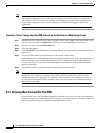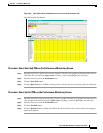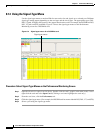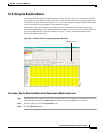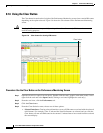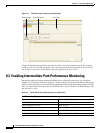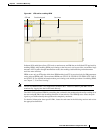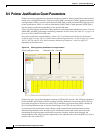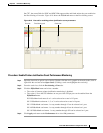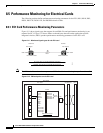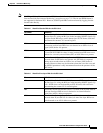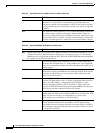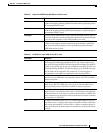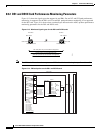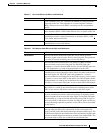
8-12
Cisco ONS 15454 Installation and Operations Guide
November 2001
Chapter 8 Performance Monitoring
Pointer Justification Count Parameters
8.4 Pointer Justification Count Parameters
Pointers are used to compensate for frequency and phase variations. Pointer justification counts indicate
timing errors on SONET networks. There are positive (PPJC) and negative (NPJC) pointer justification
count parameters. PPJC is a count of path-detected (PPJC-Pdet) or path-generated (PPJC-Pgen) positive
pointer justifications. NPJC is a count of path-detected (NPJC-Pdet) or path-generated (NPJC-Pgen)
negative pointer justifications depending on the specific PM name.
Figure 8-9 shows pointer justification count parameters on the Performance Monitoring screen. You can
enable PPJC and NPJC performance monitoring parameters for LTE cards. See Table 8-1 on page 8-10
for a list of Cisco ONS 15454 LTE cards.
For pointer justification count definitions, see the “EC1 Card Performance Monitoring Parameters”
section on page 8-14, the “OC-3 Card Performance Monitoring Parameters” section on page 8-33, or the
“OC-12, OC-48, and OC-192 Card Performance Monitoring Parameters” section on page 8-37
depending on the cards in use.
Figure 8-9 Viewing pointer justification count parameters
Pointers provide a way to align the phase variations in STS and VT payloads. The STS payload pointer is
located in the H1 and H2 bytes of the line overhead. Clocking differences are measured by the offset in
bytes from the pointer to the first byte of the STS synchronous payload envelope (SPE) called the J1
byte. Clocking differences that exceed the normal range of 0 to 782 can cause data loss.
A consistent pointer justification count indicates clock synchronization problems between nodes.
Detected and generated counts should be equal. A difference between the counts means the node
transmitting the original pointer justification has timing variations with the node detecting and
transmitting this count. Positive pointer adjustments occur when the frame rate of the SPE is too slow in
relation to the rate of the STS 1.
61947
Performance tab Card viewPointer justification counts



